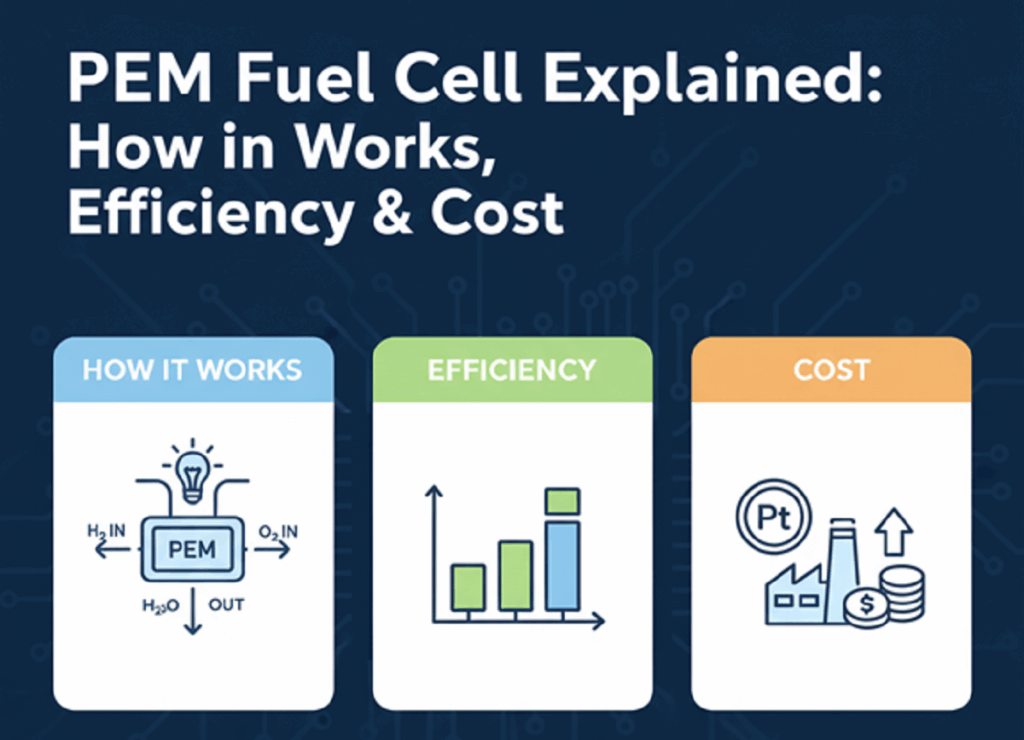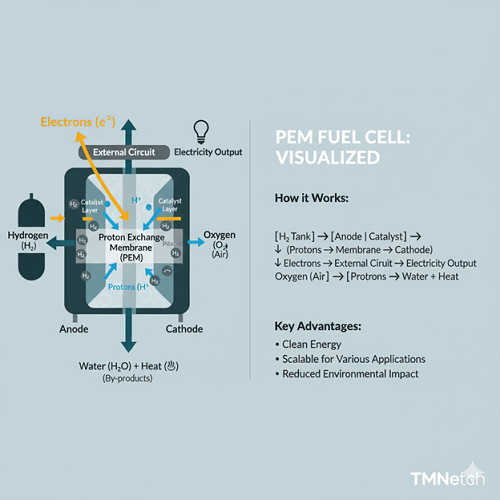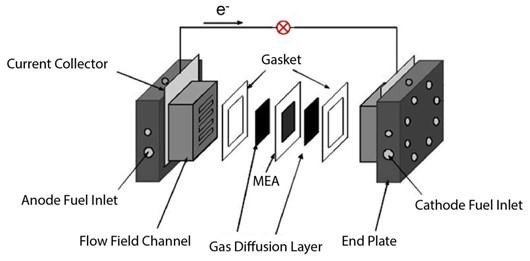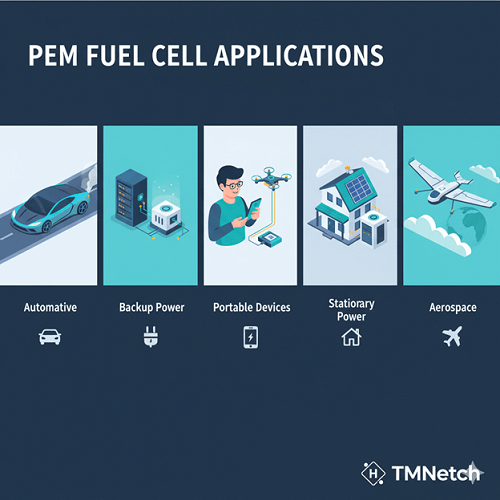A PEM fuel cell is one of the energy technologies that is considered the most competitive, efficient, and cleanest source in the contemporary world. These types of cells are used in many different sectors, including transportation and stationary power generation. Companies like TMNetch highlight the importance of advanced materials and engineering in driving innovations in PEM fuel cell components and overall system design.
Knowing how a PEM fuel cell works, its construction and performance aspects, such as PEM fuel cell efficiency, can guide professionals or researchers in making informed decisions. We are going to discuss PEM fuel cell components, applications, and more details in this article.

How a PEM Fuel Cell Works
If you want to properly understand what this technology is capable of, then it’s worth taking a closer look at how a PEM fuel cell works. PEM fuel cells are different from conventional internal combustion-based energy-using devices because of their ability to directly convert the fuel into electricity. Here is a description of each part of the working mechanism:

1. Hydrogen Supply
It starts with the anode, at which hydrogen gas enters the cell. Compressed tanks are frequently used to store hydrogen, and on-site hydrogen can be generated by reforming. On entering the fuel cell, gas flows over the surface of the anode (or oxidation) electrode, coated with a catalyst such as platinum. This is where the first chemical reaction begins, which is crucial to the overall PEM fuel cell efficiency.
2. Electrochemical Reaction at the Anode
When the hydrogen molecules reach the anode, they are broken down into two fragments: protons (H+) and electrons (e-). This process is accelerated by the platinum-activated catalyst. Without this, the chemical reaction would take place too slowly to be useful for energy production. This separation creates the potential for power production by routing the protons and electrons on diverging paths, allowing for efficient PEM fuel cell components operation.
3. Membrane Performance – Why it is the Heart of PEM
A PEM fuel cell’s essence is a proton exchange membrane (PEM). This very thin, solid polymer conducts protons (It’s an electrolyte) and does not conduct electrons. Protons can be transported through the membrane directly to the cathode. The electrons cannot jump over and must flow through an external circuit. It is this diverting of the electrons that results in current and hence electricity flow, thus just how a PEM fuel cell works.
4. Electron Flow – Generating Electricity
The electrons (from the pair) move, now in an extramembrane region, through an external electric circuit. As they move, they create an electric current that can be harnessed. This flow can be used to drive engines, charge batteries, or feed into the grid. The electron pathway is nothing more than the functional power output of a PEM fuel cell. A great thing to have when one is considering PEM fuel cell applications.
5. Oxygen Reaction at the Cathode
On the cathode side of the membrane, oxygen gas (from the air) is fed. These protons, as they come to the membrane, combine with electrons (which have travelled around the external circuit) together with oxygen molecules. Together, they produce only water (H2O) as a byproduct. The normal product of the cell’s operation is water as vapor and heat. This clean process explains the advantages of PEM fuel cells for sustainable power.
6. Heat and Water Management
In addition to generating electricity, the process also generates heat and water. Heat can be usefully recovered for cogeneration purposes, increasing PEM fuel cell efficiency. How the water is managed is also crucial. But if you add too little, the membrane dries out and loses its effectiveness; too much seeps in and floods the electrodes with water, blocking the flow of gas. The right equilibrium is achieved by optimized PEM fuel cell components.
7. Continuous Power Generation
As long as there is a constant stream of hydrogen and oxygen, the reaction doesn’t cease. As batteries wear out, PEM fuel cells will still produce electricity while they have a supply of fuel. This makes it ideal for long-life PEM fuel cell applications such as buses and trucks or range extenders.
PEM Fuel Cell Components
Each PEM fuel cell requires specific parts to facilitate the reaction. Here’s a breakdown of the main PEM fuel cell components:
1. Catalyst Layer (Catalyst Materials): Typically made of platinum-based catalysts, this layer promotes the electrochemical reactions that generate electricity.
2. Proton Exchange Membrane (Electrolyte Membrane): A solid polymer membrane that conducts protons while blocking electrons and gases, ensuring proper separation between hydrogen and oxygen.
3. Gas Diffusion Layer (GDL): A porous carbon-based layer that distributes reactant gases evenly across the catalyst surface and helps remove generated water.
4. Bipolar Plates – Core Structural and Functional Component: Bipolar plates are responsible for distributing fuel and oxidant gases, conducting electrical current between cells, and managing heat and water.
TMNetch Bipolar Plates are manufactured with high precision using advanced chemical etching technology, ensuring excellent flow channel accuracy, corrosion resistance, and high electrical conductivity—ideal for high-efficiency PEM fuel cell stacks.
5. Air Compressor: Supplies pressurized oxygen or air to the fuel cell system to improve reaction efficiency and maintain stable operation.

Components and their Impact Table
| PEM Fuel Cell Component | Description | Function | Impact on PEM Fuel Cell Efficiency |
| Catalyst Layer (Catalyst Materials) | Made of platinum-based catalysts that promote electrochemical reactions. | Drives hydrogen and oxygen reactions efficiently. | Enhances reaction rates but increases the cost of PEM fuel cell. |
| Proton Exchange Membrane (Electrolyte Membrane) | Solid polymer that conducts protons and blocks electrons and gases. | Maintains separation between hydrogen and oxygen. | Ensures high PEM fuel cell efficiency and safe operation. |
| Gas Diffusion Layer (GDL) | The porous carbon layer distributes gases and removes water. | Provides uniform gas flow and moisture balance. | Prevents flooding and sustains consistent PEM fuel cell efficiency. |
| Bipolar Plates – Core Structural and Functional Component | Distributes gases, conducts current, and manages heat and water. | Structural backbone of the fuel cell stack. | TMNetch Bipolar Plates offer precision flow channels and high conductivity, improving PEM fuel cell components’ durability. |
| Air Compressor | Supplies pressurized oxygen or air to the system. | Maintains stable operation and enhances reaction performance. | Improves overall PEM fuel cell efficiency during high-load conditions. |
Advantages of PEM Fuel Cells
Advantages of PEM fuel cells have a number of benefits, which is probably why industries are increasingly adopting them fast:
- Highly Efficient: A Higher level of energetic conversion than combustion engines.
- Environmentally Friendly: generates only water vapour and heat.
- Quick Start-Up: Great replacement for need-it-now vehicles.
- Scalable: Use small portable devices to huge power plants.
- Silent Running: Low sound levels make them suitable for use in urban areas.
Combined, these advantages underscore the environmental and economic potential of deploying the cost of PEM fuel cells.
PEM Fuel Cell Efficiency
PEM fuel cell efficiency is one of the main performance indices. That said, efficiency is generally in the range of 40%–60%, higher in CHP systems. The distinction is more obvious relative to internal combustion engines (20–30%).
- Operational Efficiency: Good with steady state.
- The temperature Factor: Effective at lower operating temperatures (50–100°C).
- Efficiency of use: How well is hydrogen utilized with as little waste as possible?
These attributes render the advantages of PEM fuel cells particularly appealing in both transportation and stationary power markets.
Cost of PEM Fuel Cell
The cost of PEM fuel cell systems remains a formidable challenge. Costs are currently more expensive than traditional fuels, partly because of pricey catalysts such as platinum. But in continuing research, costs are being reduced by:
- Material Substitution: Alternative catalysts reduce reliance on platinum.
- Mass Production: The larger the production process, the more the unit price decreases.
- Durability Improvements: Long life reduces the cost of replacement.
Country-Wise Estimates: Cost of PEM Fuel Cells
| Country | Estimated Cost (per kW) | Notes on the Cost of PEM Fuel Cell |
| United States | $1,000 – $1,500 | More expensive due to reliance on platinum and limited production. |
| Germany | $900 – $1,300 | The cost of PEM fuel cells is cheaper due to government subsidies. |
| Japan | $800 – $1,200 | A robust hydrogen infrastructure makes the installation cheaper |
| China | $700 – $1,000 | Mass production can reduce the cost of PEM fuel cells greatly. |
| South Korea | $850 – $1,200 | Investments in fuel cell vehicles drive down unit prices. |
These are rough numbers and depend on system size, type of application, as well as local regulations. With the progress of technology, it is anticipated that the cost of the PEM fuel cell system will decrease globally.
PEM Fuel Cell Applications
PEM fuel cell applications in various industries :

- Automobiles: Fueling a bus or car that produces no emissions.
- Backup Power: Ensure continuous standby power for hospitals and data centers.
- Mobile Gear: Your laptops, phones, and military equipment.
- Stationary Power: Electricity for homes and buildings.
- Aerospace: Studies of how to fuel planes and drones.
These varied PEM fuel cell applications illustrate the adaptability of the technology and support a worldwide trend towards clean power.
FAQs
Q1: How does a proton exchange membrane fuel cell produce an electric current?
A PEM fuel cell separates hydrogen into protons and electrons. This allows protons to cross the membrane; elsewhere in the cell, electrons generate current, then recombine with oxygen to make water.
Q2: What is a PEM fuel cell made of?
The main components of the PEM fuel cell are: the proton exchange membrane, electrodes (cathode and anode), catalyst layer, gas diffusion layer, and flow plates. All of them are involved in energy conversion.
Q3: Why is it said that PEM fuel cells are efficient?
High PEM fuel cell efficiency derives from the direct electrochemical conversion at high efficiencies without heating up to 1000°C or more, as with combustion systems, which suffer energy losses, resulting in only 40 -60 % efficiency.
Q4: What industries use PEM fuel cells the most?
The primary applications of PEM fuel cells are automotive, portable electronic devices, back-up power, and stationary power systems. Aerospace is also looking at potential uses going forward.
Conclusion
You could be mistaken. The PEM fuel cell is a very viable technology for a clean source of energy. Incorporating high PEM fuel cell efficiency, flexible PEM fuel cell applications, and green design, it is a viable alternative for replacing fossil fuels. Although the cost of PEM fuel cell systems remains high, companies like TMNetch are supporting research, materials innovation, and engineering solutions that make these systems more practical for industry adoption. Despite their numerous advantages of PEM fuel cells are still a viable option for a cleaner future.
